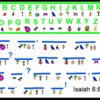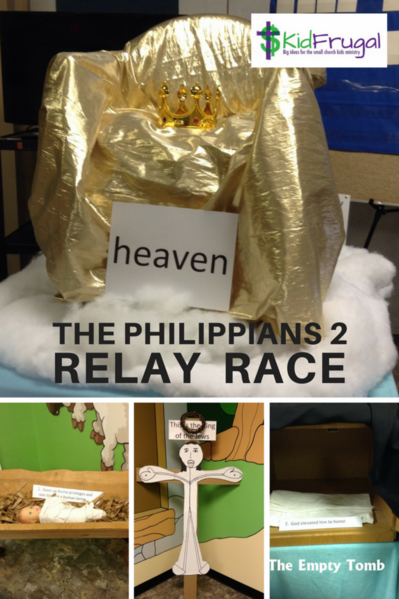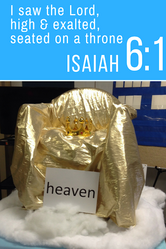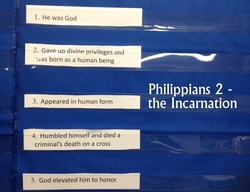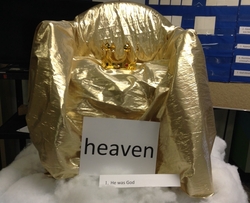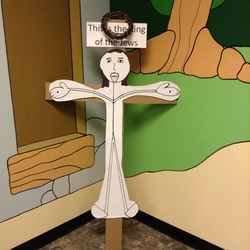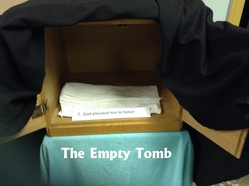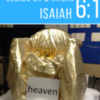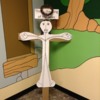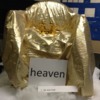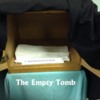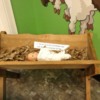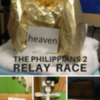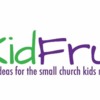Isaiah 6: "Send Me!"
Summary of Workshops:
- Computer/Video: see video clips from “Jesus of Nazareth ” and then use "Kid Pix 4 or the newer "3D" version" software to create a "coded" scripture puzzle.
- Drama/Music: sheep puppet tells Isaiah's story and then students visit the sanctuary and talk about Temple worship, followed by acting out the story, then finishing with "Sanctuary Game".
Bible Study for Teachers
Isaiah
The book of Isaiah is the first of seventeen books in the section of the Old Testament called "The Prophets." Isaiah can be divided into two major parts, with an historical narrative about Hezekiah, King of Judah, in between.
Isaiah served in Judah before the captivity. The first section exalts the righteousness, holiness and justice of God. It is also a book of condemnation against those who had been unfaithful to God. A dark cloud of judgment is cast by Isaiah's prophecies over Judah, Judah's neighbors, and the whole world. For all have gone their own way against God.
The final section is a book of comfort. The faithful God will keep his promise to his people. A Messiah will come to God's people and turn them to faith and bring them salvation.
Isaiah is a book about Jesus Christ, the Messiah, who is to come.
What does it say?
The book of Isaiah can be thought of as two books in one: a book of judgment and a book of comfort.
Chapters 1-39 (the book of judgment) is a message of rebuke against Judah for breaking the covenant. It also contains judgment against the nations, including such nations as Assyria, Philistia, and Babylon. There is occasional mention of the promise of restoration, which is the primary theme of book two. Book one closes with judgment executed through the Babylonian destruction of Jerusalem and the exile of the people of Judah.
Chapters 40-66 (the book of comfort) is a message of deliverance and restoration. It describes the coming of the victorious God of Israel who will regather and renew God's people and destroy her enemies. It speaks much of the coming savior and Israel's king who will reign in great glory.
Faces & Places
Isaiah is often thought of as the greatest of the writing prophets. Isaiah, whose name means "The Lord saves," lived in Jerusalem during the reigns of Uzziah, Jotham, Ahaz, and Hezekiah.
When King Sennacherib's Assyrian army threatened Jerusalem, King Hezekiah prayed earnestly, and the threat was removed (37:6-7). Jerusalem was later attacked and destroyed by the Babylonians. Cyrus the Persian, who would later unite the Medes and Persians, conquered Babylon in 539 (41:2). In 538, Cyrus issued a decree allowing the Jews to return home. This deliverance is a preview the great salvation from sin through Christ (52:7).
Key Verses & Themes
Judgment:
Isaiah 5:25 "Therefore the Lord's anger burns against his people; his hand is raised and he strikes them down. The mountains shake, and the dead bodies are like refuse in the streets. Yet for all this, his anger is not turned away, his hand is still upraised."
Salvation:
Isaiah 53:6 "We all, like sheep, have gone astray, each of us has turned to his own way; and the Lord has laid on him the iniquity of us all."
The Servant of the Lord:
Isaiah 42:1 "Here is my servant, whom I uphold, my chosen one in whom I delight; I will put my Spirit on him and he will bring justice to the nations."
So what?
One principle theme of the book of Isaiah is the Servant of the Lord, often known as "The Suffering Servant" (see chapters 42-53). This Servant is a man who gave himself up for the salvation of his people. This Servant is the Lord Jesus Christ.
As you read about the wrath of God that is revealed against sin in the first part of this book, meditate on the curse that is justly applied to your life for your rebellion and disobedience of God's perfect law. And as you read about God's grace in the second part of this book, remember that his grace can be applied to you because someone else received God's justice in your place. Christ died for you. Isaiah 53:6 "We all, like sheep, have gone astray, each of us has turned to his own way; and the Lord has laid on him the iniquity of us all."
Description of the Temple Isaiah "saw"
I Kings 6 - Solomon’s Temple
- 1 Kings 6:1
- 1 Kings 6:1-29 This passage parallels 2 Chronicles 3:1-14
- 1 Kings 6:3 The foyer was like a large porch.
- 1 Kings 6:4 These narrow, recessed windows were near the tops of the walls to help light the center of the Temple. Cross References: Ezekiel 41:16
- 1 Kings 6:7 In honor of God, the Temple in Jerusalem was built without the sound of a hammer or any other tool at the building site. This meant that the stone had to be “prefinished” (cut and shaped) miles away at the quarry. The people’s honor and respect for God extended to every aspect of constructing this house of worship. This detail is recorded not to teach us how to build a church, but to show us the importance of demonstrating care, concern, honor, and respect for God and his sanctuary. Cross References: Exodus 20:25; Deuteronomy 27:5-6
- 1 Kings 6:13 This verse summarizes the Temple’s main purpose. God promised that his eternal presence would never leave the Temple as long as one condition was met: The Israelites had to obey God’s law. Knowing how many laws they had to follow, we may think this condition was difficult. But the Israelites’ situation was much like ours today: They were not cut off from God for failing to keep some small subpoint of a law. Forgiveness was amply provided for all their sins, no matter how large or small. As you read the history of the kings, you will see that lawbreaking was the result, not the cause, of estrangement from God. The kings abandoned God in their hearts first and then failed to keep his laws. When we close our hearts to God, his power and presence soon leave us. Cross References: Exodus 25:8; Deuteronomy 31:6; Joshua 1:5
- 1 Kings 6:14 The concept of Solomon’s Temple was more like a palace for God than a place of worship. As a dwelling place for God, it was fitting for it to be ornate and beautiful. It had small inside dimensions because most worshippers gathered outside.
- 1 Kings 7:1 That Solomon took longer to build his palace than to build the Temple is not a comment on his priorities. His palace project took longer because it was part of a huge civic building project including barracks and housing for his harem.
- 1 Kings 7:23 The “Sea” was an enormous tank. Designed and used for the priests’ ceremonial washings, it was placed in the Temple court near the altar of burnt offering. There the priests washed themselves before offering sacrifices or entering the Temple (Exodus 30:17-21). Cross References: 2 Kings 25:13
- 1 Kings 7:27-39 These 10 “water carts” held basins of water. The basins were used for washing the various parts of the animal sacrifices. The basins were movable so they could be used where needed.
- 1 Kings 7:40-47 Huram’s items of bronze would look strange in today’s churches, but we use other articles to enhance worship. Stained-glass windows, crosses, pulpits, hymnbooks, and communion tables serve as aids to worship. While the instruments of worship may change, the purpose of worship should never change-to give honor and praise to God.
Isaiah's Vision
Isaiah 6
- Isaiah 6:1-4 Isaiah’s lofty view of God in 6:1-4 gives us a sense of God’s greatness, mystery, and power. Isaiah’s example of recognizing his sinfulness before God encourages us to confess our sin. His picture of forgiveness reminds us that we, too, are forgiven. When we recognize how great our God is, how sinful we are, and the extent of God’s forgiveness, we receive power to do his work. How does your concept of the greatness of God measure up to Isaiah’s?
- Isaiah 6:1 The year that King Uzziah died was approximately 740 b.c. He remained leprous until he died because he tried to take over the high priest’s duties (2 Chronicles 26:18-21). Although Uzziah was generally a good king with a long and prosperous reign, many of his people turned away from God. Cross References: Isaiah 6:1-2 Kings 15:7; Isaiah 1:1; John 12:41
- Isaiah 6:1ff Isaiah’s vision was his commission to be God’s messenger to his people. Isaiah was given a difficult mission. He had to tell people who believed they were blessed by God that God was going to destroy them instead because of their disobedience.
- Isaiah 6:1-3 The throne, the attending seraphim or angels, and the threefold holy all stressed God’s holiness. Seraphim were a type of angel whose name is derived from the word for “burn,” perhaps indicating their purity as God’s ministers. In a time when moral and spiritual decay had peaked, it was important for Isaiah to see God in his holiness. Holiness means “morally perfect, pure, and set apart from all sin.” We also need to discover God’s holiness. Our daily frustrations, society’s pressures, and our shortcomings narrow our view of God. We need the Bible’s view of God as high and lifted up to empower us to deal with our problems and concerns. God’s moral perfection, properly seen, will purify us from sin, cleanse our mind of our problems, and enable us to worship and to serve. Cross References: Isaiah 6:2-Revelation 4:8; Isaiah 6:3-Psalm 72:19; Revelation 4:8
- Isaiah 6:5-8 Seeing the Lord and listening to the praise of the angels, Isaiah realized that he was sinful before God, with no hope of measuring up to God’s standard of holiness. When Isaiah’s lips were touched with a live burning coal, however, he was told that his sins were forgiven. It wasn’t the coal that cleansed him, but God. In response, Isaiah submitted himself entirely to God’s service. No matter how difficult his task would be, he said, “Lord, I’ll go! Send me.” The painful cleansing process was necessary before Isaiah could fulfill the task to which God was calling him. Before we accept God’s call to speak for him to those around us, we must be cleansed as Isaiah was, confessing our sins and submitting to God’s control. Letting God purify us may be painful, but we must be purified so that we can truly represent God, who is pure and holy. Cross References: Isaiah 6:5-Jeremiah 9:3-8; 51:57; Luke 5:8; Isaiah 6:7-Isaiah 40:2; Jeremiah 1:9; 1 John 1:7
- Isaiah 6:8 The more clearly Isaiah saw God (6:5), the more aware Isaiah became of his own powerlessness and inadequacy to do anything of lasting value without God. But he was willing to be God’s spokesman. When God calls, will you also say, “Send me”?
- Isaiah 6:9-13 God told Isaiah that the people would listen but not learn from his message because their hearts had become hardened beyond repentance. God’s patience with their chronic rebellion was finally exhausted. His judgment was to abandon them to their rebellion and hardness of heart. Why did God send Isaiah if he knew the people wouldn’t listen? Although the nation itself would not repent and would reap judgment, some individuals would listen. In 6:13 God explains his plan for a remnant (holy seed) of faithful followers. God is merciful even when he judges. We can gain encouragement from God’s promise to preserve his people. If we are faithful to him, we can be sure of his mercy. Cross References: Isaiah 6:9-Acts 26:19; Romans 11:18. This verse quotes or is quoted in Matthew 13:15; Luke 8:10.
- Isaiah 6:10 This verse quotes or is quoted in Mark 4:12; John 12:40; Acts 28:26-27; Jeremiah 5:21
- Isaiah 6:11-13 When would the people listen? Only after they had come to the end and had nowhere to turn but to God. This would happen when the land was destroyed by invading armies and the people taken into captivity. The “tenth” refers either to those who remained in the land after the captivity or to those who returned from Babylon to rebuild the land. Each group was about a tenth of the total population. When will we listen to God? Must we, like Judah, go through calamities before we will listen to God’s words? Consider what God may be telling you, and obey him before time runs out. Cross References: Isaiah 6:11-Leviticus 26:31; Micah 3:12; Isaiah 6:12-Jeremiah 4:29; Isaiah 6:13-Ezra 9:2; Job 14:7
Isaiah 6
Computer/Video Workshop
Summary of Lesson Activities: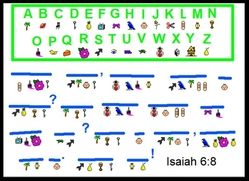
Uses video clips from “Jesus of Nazareth” and then uses Kid Pix 4 or the newer "3D" version software to create a "coded" scripture puzzle.
Scripture Reference:
Isaiah 6
Memory Verse:
Isaiah 6:8 “Then I heard the voice of the Lord saying, “Whom shall I send, and who will go for Us?” And I said, “Here am I! Send me.”
Supplies List:
- Jesus of Nazareth DVD
- Kid Pix 4 or the newer "3D" version software
- Scripture Verse printed
- Sample of a Scripture Code Puzzle (attached)
- Kid_Pix_Tips_to_Create_Scripture_Code_Puzzle.pdf (attached)
Leader Preparation:
- Gather the materials.
- Read the scripture ahead of time.
- Make copies of the scripture verse, for students, for the Scripture Code Puzzle (you may wish to have a shorter version, for younger students).
- Install and preview the software.
- Print off the Kid_Pix_Tips_to_Create_Scripture_Code_Puzzle.pdf for each student (or helper)
- Have the DVD ready to go, preset to start at first clip.
Presentation
Opening-Welcome and Lesson Introduction:
Greet the children and introduce yourself.
Open with a prayer.
Dig-Main Content and Reflection:
Explain how Isaiah who lived 700 years before Jesus tells about about Jesus in great detail. Isaiah is quoted more than any other Old Testament writer in the Gospels. God gave Isaiah His special words to warn the people to live right and to not give up hope that a Savior was coming.
Watch Clips from Jesus of Nazareth
Tell the students to turn to Isaiah 61:1-2. Read it aloud, then tell them to listen for these verses in the film clip they are about to watch.
Clip #1: This is Jesus when He first comes back to His hometown, Nazareth, to tell them that He is the promised Savior. Watch for the verse from Isaiah and watch how the people act toward Jesus when they hear His news.
Start the movie from where the women are running to tell Mary that Jesus is in town….end the clip after two disciples run after Jesus to catch up with Him.
Make sure that everyone caught the Isaiah verse references.
Clip #2: This part of the movie shows the saddest moment in all of history, when Jesus died for our sins. The man watching and quoting Isaiah is Nicodemus. He was a Pharisee, a man who was part of the religious leadership of the temple. He wasn’t sure that Jesus really was the Son of God. But when Nicodemus sees Jesus on the cross and understands what Isaiah said, his mind is made up. What did Nicodemus conclude? Look up Isaiah 53 and see how many of the words you can follow along with in your Bible.
Again, make sure that everyone understands that Isaiah, writing 700 years before Jesus lived, described in detail how and why Jesus would die.
Kid Pix 4 Computer Activity: (30 MIN)
(Grades K-3) Show the students the “coded” theme verse example (if this is the second week of your rotation you will have copies of last weeks students "code" puzzles for samples). Explain that they are going to create their own coded memory verse, but use symbols and pictures that they choose.
(K-1) class do the shorter version of the verse and (2-3) class do the entire verse.
Have each student save their work. We printed them after class and handed them out the following week at their next rotation. You may wish to have them print their own, if everyone is hooked up to a printer.
Editor has added the following Section on how to create a "coded" scripture puzzle in Kid Pix 4.
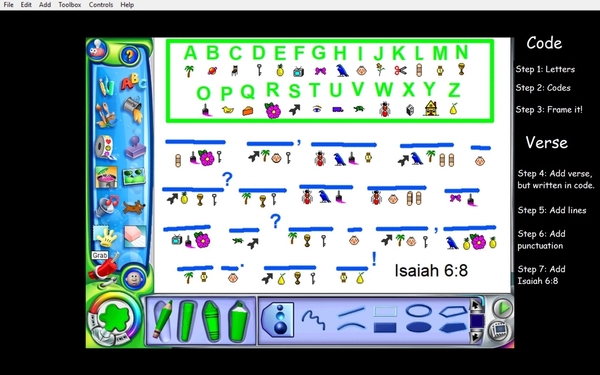
Everyone at the computers. Review with students the different areas they will be using and how to access and use each, as noted in the Kid Pix 4 Tips.
ABC: Show them how to turn Small Kids Mode ON, then insert a letter and punctuation, then turn Small Kids Mode OFF. Type a word, then adjust text box size and move it.
Stamps: insert a "code" stamp.
Draw: 1) draw some short lines, by selecting the straight line. 2) Then draw a frame around some of your test letters by selecting the empty square (box) shape, pick a corner where you want the frame to go, then drag the frame to the size you want, click to finish. Note: you can't move the frame afterwards.
Color: How to select different colours for their letters/text.
Eraser: in case they make a mistake.
Hand: how they can draw around something and move it. This may come in handy when they start adding the lines and find they need more space between certain words, for example.
Face: Erase the last thing they did.
Dynomite: blow up their test page, showing them what not to use!
File - Save: How they will save their work. Have them save the now blank page and give it the name for their "coded" puzzle. Now as they work it is recommended they keep saving their work, during and after each step, this way if they mess up, they can open their last save and continue from there, instead of starting from scratch!
Hand out verse they will be coding. If two or more students are at a computer they should take turns using the mouse (example: input 3 things, then switch to next person). When it comes time to inputting coded verse (example: three kids at one computer - one person holds the paper scripture and spells out word(s), second person looks at screen to see what that letter's symbol (code) is, and third person then finds that symbol (code) and inserts it, switch duties every word or few words. (Note: Attached is printable directions you can give to students.)
Step 1: Letters - start at top of page and insert the alphabet, top row letters A-to-N, bottom row letters 0-to-Z, remember to leave space beneath both rows for adding "codes" (symbols). SAVE!
Step 2: Code - under each letter insert a special "code" (stamp) of your choosing. SAVE!
Step 3: Frame it! - Around your code draw a box (select the empty square (box) shape). SAVE!
Step 4: Verse in Code - Add your verse in "Code" (stamps), using your Code Guide you just created and the Scripture verse handout as your word guide. Remember to leave a space above each line of code for your "fill-in" blanks. SAVE!
Step 5: Lines - Draw a line above each "coded" (word) to create your "fill-in" blanks. SAVE!
Step 6: Punctuation - Insert verse punctuation (? . , ! ). SAVE!
Step 7: Write Isaiah 6:8. Position. SAVE!
Print (if your teacher tells you to.) If students can print there puzzle they may want to keep one and print another to share with another student. OR they can fill-in-blanks on-screen, just use the letters in the ABC (Small Kids Mode ON).
Debrief: (5-10 MIN)
As you have time review ISTEP questions for rotation with students (see endnote ¹).
Closing:
End with a prayer.
Isaiah 6
Drama/Music Workshop
Summary of Lesson Activities:
Exploring the church to learn about the temples of Isaiah's time.
Scripture Reference:
Isaiah 6 & I Kings 6
Memory Verse:
Isaiah 6:8 “Then I heard the voice of the Lord saying, “Whom shall I send, and who will go for Us?” And I said, “Here am I! Send me.”
Leader Preparation:
- Gather the materials.
- Read the scripture ahead of time.
- Familiarize yourself with scripts, puppet, songs and “Sanctuary Game”
Supplies List:
- Copies of verse pictures (search internet for memory verse picture or see endnote ³ for a suggestion) and/or paper and markers.
- Copy of Sheep Puppet Script for puppeteer (teacher).
- Copies of "Isaiah in the Temple" script, enough for each student.
(Editor's Note: script not included, see endnote ² for links to some online scripts.) - Copies of song sheets, enough for each student.
(Editor's Note: songs suggested in lesson are “Here I am, Lord,” “Holy, Holy, Holy,” and “I Have the Joy!!”, song sheets are not provided.) - Ellison cutter and puzzle die
- Envelopes for puzzle pieces
- Sheep Puppet
Presentation
Opening-Welcome and Lesson Introduction:
Greet the children and introduce yourself.
Puzzle Arrival activity:
(K-1) Have students color picture of Isaiah.
(2-5) Have students creatively write the theme verse and decorate it as they wish.
Use the Ellison cutter and puzzle die for them to make their verses into puzzles and then reassemble them. Put them into envelopes for them to take home.
Begin class with prayer.
Dear Lord, We come together to worship You and to learn how to obey You. Give us willing hearts and open minds that we may always choose Your will in our lives. In the name of Your Son. Jesus Christ. Amen.
Dig-Main Content and Reflection:
Our story for this rotation is about a man named Isaiah. He had a special job from God; he was a prophet. What do you think a prophet does? (A prophet would speak for God; he would tell people what they had done wrong and point out what God’s will was.)
Isaiah was in the Temple in Jerusalem when God called him to this special job. Let’s hear what happened to Isaiah that day.
(Take out puppet to be Isaiah’s pet lamb. She will tell the story.)
Sheep Puppet Script
Hello boys and girls. My name is Fluffy and I’m Isaiah’s favorite little lamb. I want you to know that when God called my master, Isaiah, to be a prophet, I was scared!
I was with him that day at the temple and I was sure I was going to die right there on the spot! There were smoke and angels and bright light and a golden throne and the Lord God sitting right there looking down at Isaiah!
He knew he was a sinner before, but now he really knew it when God looked right at him. I wanted to run away. But an angel came to him.
He told God he had not told the truth and sinned with his lips. An angel put a burning coal right on his lips from the very altar of God. I thought it would burn him so bad! But instead of yelling, Isaiah bowed before God.
After that, he was different. It was almost as though God Himself had actually touched Isaiah.
Then God asked, “Whom shall I send as a messenger to my people? Who will go?”
And guess what my master Isaiah said, “Lord, I’ll go. Send me!”
I didn’t know what my job was going to be, but where ever Isaiah was going I was going too. We had work to do! And we’re ready to work for the Lord!
(Put puppet away.)
ACTIVITIES (30 MIN)
Visit Sanctuary:
Today we’re going to explore the place where we worship. Isaiah worshipped in a Temple, we worship in the sanctuary. We know from the Bible in the Book of Kings, what the Temple looked like. We’ll see how our sanctuary might be the same and what might be different.
(Walk quietly to the sanctuary. Everyone should sit down on the front pew.)
- What do you think people do when they get together to worship? (pray to God; sing songs, read from the Bible, listen to Bible stories)
If you were in the Temple like Isaiah was, it would not look much like this place of worship.
- What are these walls made of? (blocks of cement) The Temple’s walls were made of wood, some of it covered with gold. Do you see any windows? The Temple has narrow windows.
- What are you sitting in? (pews) In the Temple, there probably were no seats or chairs.
- What did we walk through to come in here? (doors with glass windows) When you walked into the Temple, you would walk through two huge wooden doors with angels, palm trees, and flowers carved into it. It was covered with gold. There was a big, tall pillar on either side of the gold doors.
- What is at the front of this sanctuary? (a table, steps, a place to read from) At the front of the Temple, you had to walk up lots of steps to get to the most holy Place. It was a smaller room, covered in gold, that contained a special box called the Ark of the covenant. The stone tablets that God gave Moses with the Ten Commandments were in this special gold box. There were two huge gold statues of creatures with wings standing on either side of the ark.
Act it out:
Now that we know a little about the Temple, let’s do a play and pretend that we are in the Temple where Isaiah talked to God. (Note: no script was provided so moderator as added some ideas below see ² Script Suggestions.
(Either stay and act out the drama in the sanctuary or return to the Drama room and act out the play. For the K-1, you read the script while the students act out the drama.)
Debrief: (10-15 MIN)
Sing one or more of these songs, “Here I am, Lord,” “Holy, Holy, Holy,” and “I Have the Joy!!” Choose the song(s) you’re most comfortable teaching and the ones appropriate to the different age levels.
As you have time you may play the “Sanctuary Game.” (see below)
¹ As you have time review ISTEP questions for rotation with students (see below).
SANCTUARY GAME
Ask students the following question and ask them to "move and touch where they think that happens" in the sanctuary. You can award points to those who 'get there first' or not.
A SIGN OF BELONGING TO GOD'S FAMILY (baptismal)
RECEIVING BREAD OF LIFE (communion table)
INTERPRETING THE WORD OF GOD (minister's area)
CONTRIBUTING SUPPORT (collection plates)
JOYFULLY ADORATION and PRAISE (choir / pews)
ASKING GOD (prayer - pews)
Of course, some of these words need interpreted!
Closing:
End with a prayer.
Endnotes
¹ Sunday School ISTEP
Increased Scriptural Thinking to Equip Presbyterians
(what we call our "reflection"!)
Learning Objective Questions
To help us set goals for Bible understanding the following are questions that we plan for the children to be able to answer at the end of the rotation.
Ask the following as noted by grade level: *(K-1st) **(2nd-3rd) All (4th-5th).
- *What was Isaiah’s response when he found himself in the presence of God during his dramatic call? (Isaiah 6:5)
- *How did God purify Isaiah? (Isaiah 6:7)
- **Who else was present when Isaiah received his call from God? (Isaiah 6:2)
- What kind of creatures were these? Would they make nice “Precious Moment” figurines? (Is. 6:2-4)
- *When Isaiah realized that God needed someone to go for him to tell the people God’s message, what did Isaiah say? (Isaiah 6:8)
- **When did Jesus quote Isaiah 61:1,2?
- Who was the one prophesied of in Isaiah 40:3?
- What did the seraphs say when they called to one another? (Isaiah 6:3)
- **How many years did Isaiah live before Christ?
- What did Isaiah record in chapter 53 about Christ that can be found no place else in the Bible? (Is. 53:2)
- How many kings ruled Judah during the lifetime of Isaiah? (Isaiah 1:1)
- Which of the kings was a good king? (2 Kings 18:2-3)
- Who was the great enemy that threatened and finally did take Israel into captivity? (Isaiah 39:6)
- What part did Jesus not quote from Isaiah 61:2? Why? (Matt. 25:31-32, Hebrews 9:28)
- What did Isaiah prophesy would finally happen for the nation of Israel? (Isaiah 58:12)
- **Identify any parts of our order of worship taken from Isaiah 6. (Is. 6:3, 5, 7, 8)
- What is the main message in the last half of the book of Isaiah? (Isaiah 40:1)
- *Who was the suffering servant in Isaiah 53? (Acts 8:32-35)
- *How did Jesus’ old friends and family feel about His comments on Isaiah 61:1,2? (Luke 4:28-29)
- What pagan king did Isaiah prophesy (even giving his precise name) some 200 years before the fact, who would allow the Israelites to return to Jerusalem? (Is. 44:28)
² Search of online scripts
³ Illustrations
Lesson plans were originally posted by Barb Shackelford.
Her church has a particular form of reflection they call ISTEP which is referenced here. You'll also see in their game lesson some info specific to their church which you would adapt.
Tips and Directions for using the software Kid Pix 4 were added by member Luanne Payne of Rotation.org.
Kid Pix 4 graphics used for educational purposes only.
A representative of Rotation.org reformatted this post to improve readability.



